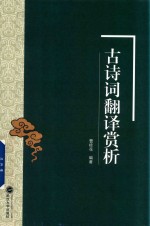

古诗词翻译赏析PDF电子书下载
- 电子书积分:11 积分如何计算积分?
- 作 者:曹桂花编著
- 出 版 社:武汉:武汉大学出版社
- 出版年份:2018
- ISBN:9787307203686
- 页数:253 页
Chapter 1 Chinese Poetry and Its Translation 1
1.1 Chinese Poetry 1
1.1.1 General History of Chinese Poetry 1
1.1.2 Classification and Characteristics of Poetry 5
1.2 Poetry Translation 8
1.3 Criteria of Poetry Translation 12
Exercises 17
Chapter 2 Poetry Appreciation and Artistic Conception 19
2.1 Poetry Appreciation 19
2.1.1 Investigating the Writing Background 19
2.1.2 Finding the Key Words in Poems 21
2.1.3 Determining the Genre of Poetry 22
2.1.4 Inspecting the Technique of Expression 22
2.1.5 Attaching Great Importance to Images 24
2.1.6 Deepening Understanding and Appreciating the Artistic Conception 24
2.2 Artistic Conception 27
2.2.1 Definition 28
2.2.2 Development History in Literature 31
2.2.3 Characteristics 33
2.2.4 Function and Aesthetic Nature/Essence 36
2.2.5 Constituents:Images,Feelings,Poetic Language and Musicality 38
2.2.6 Fuzziness and Artistic Conception 41
Exercises 42
Chapter 3 Appreciation and Analysis of Images 43
3.1 Image and Its History 44
3.1.1 History of Image 44
3.1.2 Definition 44
3.1.3 Function 46
3.2 Classification of Images 47
3.3 Appreciation and Analysis of Dynamic Images and Static Images 49
3.3.1 Employing Counterparts in TL 51
3.3.2 Shifting Static Images to Dynamic Ones or Vice Versa 59
3.4 Appreciation and Analysis of Juxtaposed Images 66
3.5 Appreciation and Analysis of Culture-loaded Images 76
3.5.1 Culture-loaded Images and Artistic Conception 78
3.5.2 Language Relativity and Cultural Default 80
3.5.3 Allusion Images 83
3.5.4 Appreciating Four Commonly Used Translating Methods 86
3.5.5 Appreciating Reproduction of Numbers in Poems 93
3.5.6 Mistranslation of Culture-loaded Images 98
Exercises 103
Chapter 4 Appreciation and Analysis of Figurative Language 105
4.1 Figurative Language in Classical Chinese Poetry Translation 105
4.1.1 Fu,Bi,Xing and Figurative Language 106
4.1.2 Importance of Figurative Language 107
4.1.3 Reproduction of Metaphor 109
4.2 Appreciation and Analysis of Metaphor 112
4.3 Appreciation and Analysis of Xing or Symbolization 119
4.3.1 Reproduction of Xing or Symbolization in Translation 119
4.3.2 Appreciation and Analysis of Xing or Symbolization 120
4.4 Appreciation of Refined Words and Expressions 127
Exercises 130
Chapter 5 Appreciation and Analysis of Musicality 132
5.1 Musicality in Classical Chinese Poetry 132
5.1.1 Rhyme 137
5.1.2 Rhythm 141
5.2 Appreciation and Analysis of Meter,Rhyme and Rhythm 142
5.3 Appreciation and Analysis of Onomatopoeia 148
Exercises 153
Chapter 6 Appreciation and Analysis of Fuzziness in Classical Chinese Poetry 155
6.1 Fuzziness in Classical Chinese Poetry Translation 155
6.2 Appreciation and Analysis of Reproduction of Fuzziness 161
6.2.1 Appreciation and Analysis of Reproduction of Fuzzy Images 161
6.2.2 Appreciation and Analysis of Reproduction of Fuzzy Numbers 173
6.3 Loss/Limitation of Fuzziness in Translation 182
Exercises 187
Chapter 7 Factors Influencing Classical Chinese Poetry Appreciation 189
7.1 Cultural Factors 193
7.2 Translator-related Factors 202
7.2.1 Translator's Own Cultural Accomplishment and Language Proficiency 203
7.2.2 Strategy of Translation 204
7.3 Reader-related Factors 205
7.4 Fuzzy Language 206
Exercises 210
Appendix 212
Bibliography 245
Acknowledgements 253
- 《英汉翻译理论的多维阐释及应用剖析》常瑞娟著 2019
- 《当代翻译美学的理论诠释与应用解读》宁建庚著 2019
- 《社会文化系统中的翻译》姜秋霞,杨正军 2019
- 《2020考研英语大趋势 历年真题完形+翻译+新题型精讲精练》商志 2019
- 《李辅耀诗词集》李崧峻主编 2019
- 《潜文本的阐释与翻译》刘早著 2019
- 《财经新闻翻译实践教程》胡婉,黄剑,王旭泉主编 2019
- 《一本书备考高考古诗词》王大绩 2017
- 《一蓑烟雨任平生 咏史卷 向上吧!诗词》《意林》图书部编 2019
- 《文化转向视角下的英汉翻译问题再审视》王燕著 2020
- 《市政工程基础》杨岚编著 2009
- 《家畜百宝 猪、牛、羊、鸡的综合利用》山西省商业厅组织技术处编著 1959
- 《《道德经》200句》崇贤书院编著 2018
- 《高级英语阅读与听说教程》刘秀梅编著 2019
- 《计算机网络与通信基础》谢雨飞,田启川编著 2019
- 《看图自学吉他弹唱教程》陈飞编著 2019
- 《法语词汇认知联想记忆法》刘莲编著 2020
- 《培智学校义务教育实验教科书教师教学用书 生活适应 二年级 上》人民教育出版社,课程教材研究所,特殊教育课程教材研究中心编著 2019
- 《国家社科基金项目申报规范 技巧与案例 第3版 2020》文传浩,夏宇编著 2019
- 《流体力学》张扬军,彭杰,诸葛伟林编著 2019
- 《大学计算机实验指导及习题解答》曹成志,宋长龙 2019
- 《大学生心理健康与人生发展》王琳责任编辑;(中国)肖宇 2019
- 《大学英语四级考试全真试题 标准模拟 四级》汪开虎主编 2012
- 《大学英语教学的跨文化交际视角研究与创新发展》许丽云,刘枫,尚利明著 2020
- 《复旦大学新闻学院教授学术丛书 新闻实务随想录》刘海贵 2019
- 《大学英语综合教程 1》王佃春,骆敏主编 2015
- 《大学物理简明教程 下 第2版》施卫主编 2020
- 《大学化学实验》李爱勤,侯学会主编 2016
- 《中国十大出版家》王震,贺越明著 1991
- 《近代民营出版机构的英语函授教育 以“商务、中华、开明”函授学校为个案 1915年-1946年版》丁伟 2017
